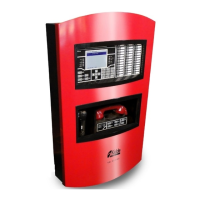
Do you have a question about the Kidde VM Series and is the answer not in the manual?
| Model | VM Series |
|---|---|
| Operating Temperature | 32°F to 120°F (0°C to 49°C) |
| Relative Humidity | 10% to 93% non-condensing |
| Product Type | Control Panel |
| Input Voltage | 120/240V AC |
| Frequency | 50/60 Hz |
| Battery Backup | 24V DC |
| Display | LCD |
Overview of the VM Series Head End system, including its components and capabilities.
Covers various intelligent initiating devices like smoke, heat, and CO detectors.
Comprehensive range of notification appliances for fire alarm signaling.
Devices designed for safe operation in hazardous and explosive environments.
Devices for holding doors open and providing control relay functions.
Diagrams and explanations of system layout and wiring for the Head End.
Physical assembly and dimensional specifications for the VM Series Head End.
Details on operating the VM Series Head End control panel and its functions.
Information about the different VM Series control panel models available.
Lists and describes the standard equipment included with VM Series control panels.
Options for networking VM Series panels for expanded communication.
Available audio and paging capabilities for the VM Series system.
Various adapter cards to enhance VM Series functionality and connectivity.
Details on operator interfaces, displays, and annunciators for VM Series control panels.
Information on R-Series annunciators for VM Series systems, including models and features.
Details on remote booster and auxiliary power supplies for VM Series systems.
Various accessories available for the VM Series system, such as GFD modules.
Details on KI-Series optical, heat, and combination intelligent detectors.
Information on mounting bases for KI-Series detectors, including standard, isolator, and relay types.
Audible bases for KI-Series detectors, providing sounder functions for alarms.
Intelligent addressable smoke detectors designed for ductwork installation.
Flexible modules for gathering intelligent information and converting it to digital signals.
Module for connecting initiating, appliance, or two-wire smoke circuits in Class A or B.
Module for connecting Class B normally-open dry contact initiating device circuits.
Module for monitoring waterflow alarm and supervisory/tamper switches.
Device that allows part of a data loop to continue operating during a short circuit.
Module for monitoring input from devices like fans, dampers, and doors.
Connects signal or telephone circuits to power inputs for audible/visual appliances.
Module providing a dry relay contact for controlling external appliances.
Module that reverses polarity to activate sounder bases.
Connects supervised output circuit to a riser for synchronization.
Various manual pull stations for initiating alarms.
Device to prevent false alarms on manual pull stations with a warning horn.
Explains field wiring configurations for notification appliances like Class A/B circuits.
Details on how strobes are synchronized to meet UL 1971 standards.
Lists control panels, power supplies, and modules that provide synchronization sources.
Overview of Genesis line of visual and audible signaling devices.
Details on EG1 Series wall-mount strobes, horns, and chimes.
Information on GC Series ceiling-mount speakers and speaker-strobes.
WG4 Series weatherproof horns, horn-strobes, speakers, and speaker-strobes.
GL Series LED strobes and horn-strobes with low-profile design.
Details on Genesis fire alarm speakers and speaker-strobes.
High fidelity models with enhanced features for fire alarm applications.
High fidelity models for mass notification applications.
Speakers and speaker-strobes for mass notification with specific configurations.
WG4 Series weatherproof speakers and speaker-strobes for outdoor use.
Fire alarm telephones for emergency communication in strategic locations.
Devices meeting UL 1971 synchronization requirements for harsh environments.
Weatherproof, high-efficiency speakers for public and outdoor areas.
Horns and horn-strobes with temporal or steady tone output, suitable for outdoor use.
Strobes for standard 4" square electrical boxes, self-synchronized.
Various audible signaling devices including bells, multiple tone signals, and loudspeakers.
Accessories for notification appliances, like bell/strobe plates and lens marking kits.
Definitions of hazardous location classes, divisions, and groups based on NEC standards.
Heat detectors designed for normal environments and those subject to weather or explosive atmospheres.
Manual pull stations built for hazardous locations, offering explosionproof and weatherproof features.
Explosionproof smoke detectors for use in hazardous locations.
Signaling appliances designed for installation in hazardous environments.
Diode-polarized, heavy-duty fire bells for life safety applications in hazardous locations.
Diode-polarized, heavy-duty horns for hazardous (classified) locations.
Devices that keep doors open until signaled by the fire alarm system, releasing upon power failure.
Relays for system status, remote contacts, and electrical load control.
High-capacity power relays for applications requiring 30-Amp DPDT contacts.
Single-pull/double-throw relays for controlling electrical loads and providing remote contacts.
Relays with manual override switches for ON-AUTO-OFF operation.
Relays operated by one of three input control voltages.
Relays operated by one of four input control voltages.
Encapsulated relays with 10-Amp Form C contacts.